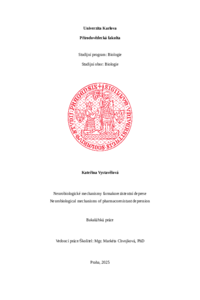Neurobiologické mechanismy farmakorezistentní deprese
Neurobiological mechanisms of pharmacoresistant depression
bachelor thesis (DEFENDED)

View/
Permanent link
http://hdl.handle.net/20.500.11956/199466Identifiers
Study Information System: 279326
Collections
- Kvalifikační práce [20861]
Author
Advisor
Consultant
Novotný, Jiří
Referee
Ladislavová, Lucie
Faculty / Institute
Faculty of Science
Discipline
Biology
Department
Department of Physiology
Date of defense
3. 6. 2025
Publisher
Univerzita Karlova, Přírodovědecká fakultaLanguage
Czech
Grade
Excellent
Keywords (Czech)
Farmakorezistentní deprese, neuroplasticita, mTOR, antidepresivum, ketaminKeywords (English)
Pharmacoresistant depression, neuroplasticity, mTOR, antidepressant, ketamineFarmakorezistentní deprese (TRD) představuje závažnou formu depresivní poruchy charakterizovanou nedostatečnou odpovědí na existující léčbu antidepresivy. V klinické praxi se týká přibližně třetiny pacientů s diagnostikovanou depresivní poruchou. Je spojena s komplexními neurobiologickými změnami, včetně narušené neuroplasticity, zvýšené neuroinflamace a dysregulace glutamátergní a monoaminové signalizace. Nové terapeutické přístupy, jako je použití ketaminu a jeho derivátu esketaminu, ukazují slibné výsledky díky podpoře synaptické plasticity a aktivaci BDNF a mTOR signální dráhy, i když jejich širší využití limitují vedlejší účinky. Nefarmakologické metody, například elektrokonvulzivní terapie nebo transkraniální magnetická stimulace, představují alternativní možnosti léčby. Hlubší pochopení patofyziologie TRD a individualizace léčby by mohlo významně přispět ke zlepšení prognózy pacientů trpících tímto onemocněním. Klíčová slova: Farmakorezistentní deprese, neuroplasticita, mTOR, antidepresivum, ketamin
Treatment resistant depression (TRD) is a severe form of depressive disorder characterized by inadequate response to existing antidepressant treatments. In clinical practice, it affects approximately one third of patients diagnosed with depressive disorder. It is associated with complex neurobiological changes, including impaired neuroplasticity, increased neuroinflammation, and dysregulation of glutamatergic and monoamine signaling. New therapeutic approaches, such as the use of ketamine and its derivative esketamine, show promising results by promoting synaptic plasticity and activating the BDNF and mTOR signaling pathways, although their wider use is limited by side effects. Non-pharmacological methods, such as electroconvulsive therapy or transcranial magnetic stimulation, represent alternative treatment options. A deeper understanding of the pathophysiology of TRD and individualization of treatment could significantly contribute to improving the prognosis of patients suffering from this disease. Key words: Pharmacoresistant depression, neuroplasticity, mTOR, antidepressant, ketamine
